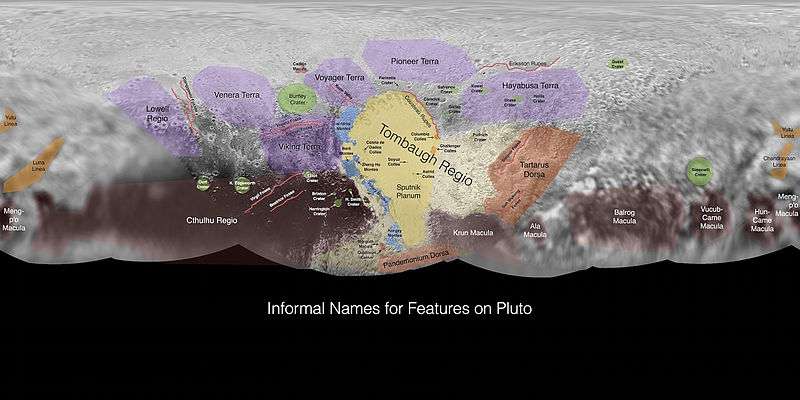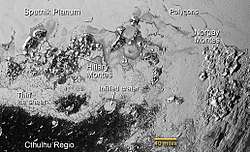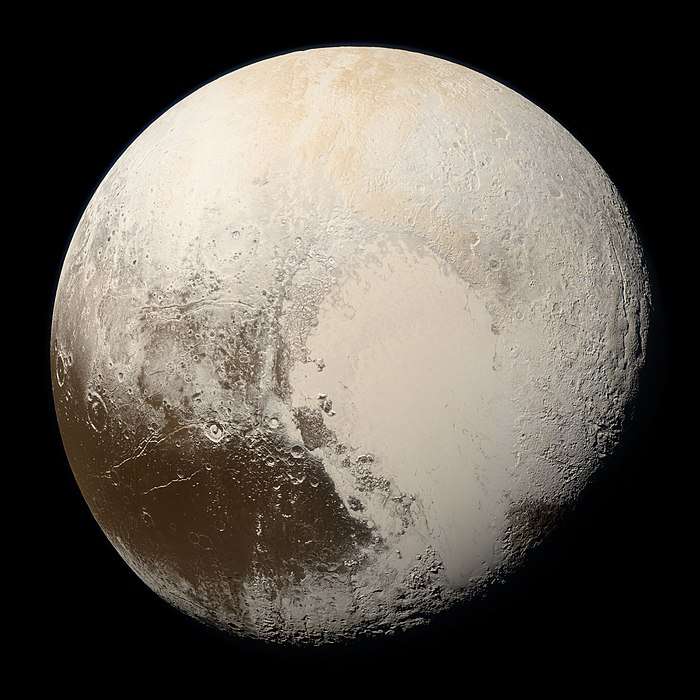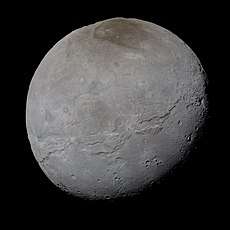Tenzing Montes
The Tenzing Montes /ˈtɛnzɪŋ ˈmɒntiːz/ (formerly Norgay Montes) are icy mountains near the Hillary Montes that reach up to 6.2 km (3.9 mi; 20,000 ft) above the surface of the dwarf planet Pluto,[3][4][5] bordering the southwest region of Sputnik Planitia in the south of Tombaugh Regio (or the part of Tombaugh Regio south of the equator).[6][7] They are the highest mountain range on Pluto, and also the steepest, with a mean slope of 19.2 degrees.[3]
 | |
| Location | Tombaugh Regio, Pluto |
|---|---|
| Coordinates | 20°S 180°E |
| Peak | 6.2±0.6 km (3.9±0.4 mi)[3] |
| Discoverer | New Horizons |
| Eponym | Tenzing Norgay |
Naming
The mountains, first viewed by the New Horizons spacecraft on 14 July 2015, and announced by NASA on 15 July 2015, are named after the Nepalese mountaineer Tenzing Norgay, who, along with Sir Edmund Hillary, made the first successful ascent of the highest peak on Earth, Mount Everest (29 May 1953).[1][2][8] The mountains were informally called Norgay Montes by the New Horizons team, but that name was later changed from Norgay to Tenzing.[note 1] On 7 September 2017, the name Tenzing Montes was officially approved together with the names of Tombaugh Regio and twelve other nearby surface features.[9]
Highest peaks
Several massifs within Tenzing Montes reach elevations of more than 4 km above the surrounding terrain. The table below is based on Table 3 in [3].
| Name of range | Peak name[note 2] | Location | Height (km, base-to-peak) |
|---|---|---|---|
| Tenzing Montes | "T2" | 16.4°S 175.6°E | 6.2±0.6 km |
| Tenzing Montes | "T1" | 16.0°S 174.9°E | 5.7±0.4 km |
| Tenzing Montes | "T3" | 16.9°S 176.3°E | 5.3±0.4 km |
| Tenzing Montes | "T4" | 21.7°S 179.7°E | 5.0±0.4 km |
| Tenzing Montes (south) | "T1 1" | 19.5°S 179.2°E | 4.5±0.4 km |
| Tenzing Montes (south) | "T1 2" | 20.3°S 178.9°E | 4.4±0.4 km |
The Tenzing Montes rise up to 6.2 km (3.9 mi; 20,000 ft) high, about twice as high as the Hillary Montes.[3] In comparison, Mount Everest rises 4.6 km (2.9 mi; 15,000 ft) base-to-peak (though to an altitude of 8.8 km (5.5 mi; 29,000 ft) above sea level).[10]
Gallery

Pluto - map features
(context; 29 July 2015).

Pluto – Hillary Montes and Tenzing Montes
(context; 14 July 2015).
Hillary Montes and Tenzing Montes
(context; 14 July 2015).
Hillary Montes and Tenzing Montes on Pluto
(context; 14 July 2015).[11]
Tenzing Montes on Pluto
(closeup; 14 July 2015).


Near-sunset view includes several layers of atmospheric haze.
Videos
See also
Notes
- In Nepali, the last name is given first, so Tenzing is the last name while Norgay is the first name.
- Informal until approval by the International Astronomical Union.
References
- Nemiroff, R.; Bonnell, J., eds. (18 July 2015). "Fly Over Pluto". Astronomy Picture of the Day. NASA. Retrieved 27 July 2015.
- Staff (17 July 2015). "NASA – Video (01:20) – Animated Flyover of Pluto's Icy Mountain and Plains". NASA & YouTube. Retrieved 18 July 2015.
- Schenk, P. M.; Beyer, R. A.; McKinnon, W. B.; Moore, J. M.; Spencer, J. R.; White, O. L.; Singer, K.; Nimmo, F.; Thomason, C.; Lauer, T. R.; Robbins, S.; Umurhan, O. M.; Grundy, W. M.; Stern, S. A.; Weaver, H. A.; Young, L. A.; Smith, K. E.; Olkin, C. (2018). "Basins, fractures and volcanoes: Global cartography and topography of Pluto from New Horizons". Icarus. 314: 400–433. doi:10.1016/j.icarus.2018.06.008.
- Kremer, Ken (27 July 2015). "Breathtaking Pluto images reveal icy dwarf planet's plains and mountains (+video) - NASA's New Horizons space probe has sent back its highest-resolution images yet of Pluto and its moons". The Christian Science Monitor. Retrieved 17 August 2015.
- Akpan, Nsikan (18 July 2015). "Nepal gets a piece of Pluto plus four new surprises from New Horizons". PBS NewsHour. Retrieved 17 August 2015.
- Staff (25 July 2015). "Pluto mountain range named after Sir Edmund Hillary". Stuff.co.nz. Retrieved 17 August 2015.
- Staff (24 July 2015). "NASA names Pluto's mountains after Sir Edmund Hillary". Television New Zealand. Retrieved 17 August 2015.
- Pokhrel, Rajan (19 July 2015). "Nepal's mountaineering fraternity happy over Pluto mountains named after Tenzing Norgay Sherpa - Nepal's First Landmark In The Solar System". The Himalayan Times. Retrieved 19 July 2015.
- "Pluto Features Given First Official Names". NASA. 7 September 2017.
- Mount Everest (1:50,000 scale map), prepared under the direction of Bradford Washburn for the Boston Museum of Science, the Swiss Foundation for Alpine Research, and the National Geographic Society, 1991, ISBN 3-85515-105-9
- Gipson, Lillian (24 July 2015). "New Horizons Discovers Flowing Ices on Pluto". NASA. Retrieved 25 July 2015.

